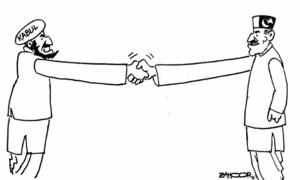
The birthplace of the poet of the East Allama Iqbal, Sialkot has many other feathers in its cap. Along with adjacent districts of Gujranwala and Gujrat, it forms the ‘golden triangle of relatively industrialised northern Punjab.
With the highest per capita income of over $3,000 in the province, the district also earns international fame through its sports, surgical instruments and leather industries, while agricultural engineering manufacturing at Daska, one of its four tehsils, makes it a household name among the domestic farming community. Located at the Indian border along the Working Boundary, it has inherited paper and ironworks industries from the pre-colonial period and takes pride in having the first privately constructed and owned airport in the country.
Tradition has it that the city, then named Sagala, existed millenniums ago and Alexander the Great had conquered and razed it to the ground in 326 BC. It was rebuilt and served as the capital of the Euthydemus dynasty’s Indo-Greek king Menander-I and prospered as a major silk trade centre being adjacent to Kashmir, home to the once popular mulberry and other varieties of silk. However, it lost its prominence and importance to Lahore by the year 1,000 and was made a suba or province of Lahore during the Mughal period.
The industrial revolution here began during the rule of Akbar the Great when papermaker migrants from Kashmir started producing Mughal Hariri paper known for its extra whiteness and strength. Local metalworkers also provided most of the weaponry to the Mughal crown then and became a hub of metalwork in the 1890s.
‘The imposition of US sanctions on Iran, one of the major importers of the local Basmati variety, has reduced rice exports to the neighbouring country and subsequently its price in the local market has plummeted, nudging farmers to shift to alternative crops’
By the 1920s, surgical instruments were being manufactured in Sialkot for use throughout British India. The availability of nearby timber reserves in the valleys of Kashmir also converted it into a centre for sports goods for the British troops stationed along with the North-West Frontier (now Khyber Pakhtunkhwa). The increased industrial activities and creation of jobs attracted a large number of migrants from Kashmir, who constitute one of the major castes of the local population. Other prominent castes included Rajput, Arain, Awan, Jat and Sayyed.
Before the 1947 Partition, Sialkot was considered as the second most industrialised city after Amritsar in Punjab and was one of the few areas in British India to have its own electric utility company. But, the communal rioting ensuing the Partition destroyed 80 per cent of the local industry in one way or the other, while the arrival of around 200,000 refugees, mostly from Jammu, further stressed the local economy. The industry, however, was soon rehabilitated under various provincial initiatives, while the entry of local entrepreneurs filled the vacuum created by the departure of Hindu and Sikh traders.
As of 2019, Sialkot exported goods worth $2.5 billion or over 10pc of total national exports ($23bn) and local industries employed about 250,000 people. Sialkot Chamber of Commerce and Industry data shows that of its over 6,500 members, most are active in sports goods, leather, and surgical instruments sectors.
The largest producer of hand-sewn footballs, Sialkot manufactures roughly between 40 and 60 million or 60pc of the total production of footballs in the world per annum. Since the 1997 international objection, there is a well-applied child labour ban in the industry under the Atlanta Agreement.
Also, the world’s largest centre of surgical instrument manufacturing emerged from the need to repair, and subsequently manufacture, surgical instruments for the nearby Mission Hospital close to the beginning of the 20th century. By the 1920s, Sialkot-made surgical instruments were being used throughout British India.
Sialkot’s share in the agriculture sector is not less than any other district. It mostly produces world-known Basmati rice varieties, wheat and sugarcane. Comprising 3,015 sq km, at least 642,624 acres of it is under cultivation, while 99,241 acres are uncultivated. Around 71 acres are under forest and 19 acres are cultivatable waste.
Wheat claims a major share of cultivable land with rice and fodder standing at second and third. These major crops are, however, losing their acreage as farmers disappointed with volatile wheat and rice markets and a stagnant per acre yield are turning towards alternative crops.
Wheat was sown on 452,00 acres in 1995 and the land under it gradually increased to 533,000 acres by 2010-11 only to see it rapidly declining to 319,00 acres in 2019-20. Likewise, the paddy crop covered an area of 402,000 acres in 1995. With a steady increase, the total land under it went up to 471,000 acres in 2007-08 and then started its downfall as it was sown on 331,000 acres last year.
Ali Khan, a paddy grower from the district, says that since the imposition of US sanctions on Iran, one of the major importers of local Basmati variety, rice exports to the neighbouring country and subsequently its price in the local market has plummeted. Seeing no earlier opening of the Iranian market, he too, like other paddy growers, has gone for alternative crops. He says that he has allocated 25pc of his lands for sugarcane as the sugar mills in the district became functional after lying dormant for around one and half decades, and a similar portion of land for guava orchards.
Mr Khan says that maize and millet are also being adopted as alternative crops by farmers as acreage of maize has more than doubled during the last five years — from 51,000 acres in 2015 to 126,000 in 2020.
Attempts were made to popularise sugarcane in the area after a businessman from Chiniot took over the Pasrur Sugar Mills last year but so far the acreage of the water-guzzling crop is stagnant at 3,000 acres and has not increased even though the area under it once hovered around 115,000 acres back in the 1990s.
Potato and sunflower were prominent among the minor crops in the district. Potatoes were planted on 158,100 acres in 1995 and the next 10 years saw around a 60pc increase in its acreage before the beginning of its decline. It stood at 115,000 acres last year. The story of the oilseed crop sunflower is no different. The crop was once sown on 70,000 acres but is now planted hardly on 7,000 acres in the district.
Most of the lands allocated for oilseeds and vegetables have unfortunately fallen prey to the mushroom growth of housing societies emerging around urban centres because of the influx of rural population towards towns to seek employment as well as better education and health facilities for their children.
Dr Abdul Sami, a former official of the agriculture department from Sialkot, points out that because of the suspension of trade ties with India sunflower seed could not be imported from there. He regrets that once Quetta used to supply seeds for canola and other oilseed crops to the sub-continent but now the country is forced to import the same from India.
According to him, poor marketing of agricultural produce is the main issue for most of the farmers, who cannot also fix the price of their product, unlike other sectors. Unstable and non-transparent price mechanisms at vegetable, fruit and grain markets are hitting both the farmers and consumers, while the middlemen are pocketing most of the profit.
Referring to the bumper wheat crop just harvested by Punjab, he says the offer of a good return for their labour and investment made the farmers work hard and achieve around 1.5m tonnes more grain year on year. Pointing out a major hurdle in getting good crop yields in Sialkot, he says that a vast majority of farms are too small in size in the district, unable to provide sustenance to a family on its own. So, these landowners are doing part-time farming that leads to higher production costs and lower yields.
Published in Dawn, The Business and Finance Weekly, May 24th, 2021












































